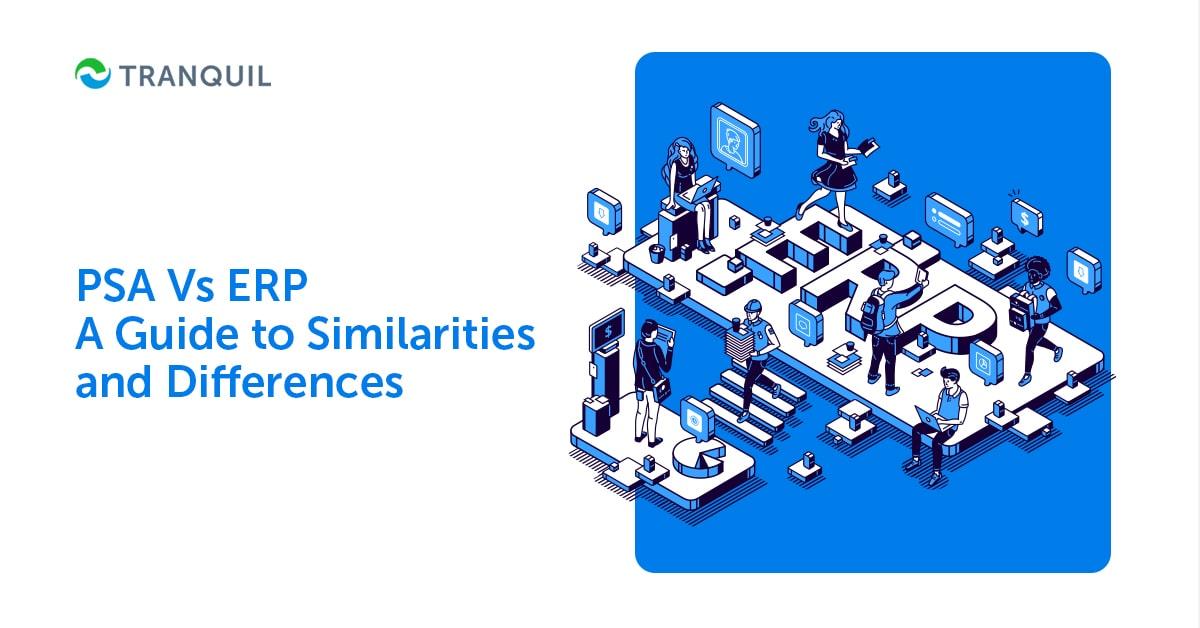
PSA Vs ERP A Guide to Similarities and Differences
The modern business environment necessitates agility, quick response and competitiveness in the marketplace.
Ergo, organizations are increasingly adopting technology to help them achieve this and more.
Numerous software solutions are available that facilitate digital transformation.
Let’s examine two such systems today and see how PSA Vs ERP match up head-to-head.
ALSO READ: Guide on How Do ERP Systems Work
What is ERP?

ERP or enterprise resource planning is a software solution that organizations implement to streamline, automate, and integrate routine business activities, and foster better collaboration between departments.
It gets rid of information silos and centralizes data, which helps employees across the organization to access any information they need to make the right decisions for the business.
ALSO READ: ERP vs CRM
ERP Business Functionalities
ERP software comprises of modules that handle business functionalities:
Financial Management
This is at the core of ERP software, and it gives a bird’s eye-view of the financial health of your business; you can see how money moves through your company, and manage it better.
This module takes care of cash outflows and inflows, manages the ledger, performs bank reconciliation, minimizes manual effort, and helps you comply with regulations.
Human Resources
You can streamline your HR processes, with automated workflows that help you manage the entire lifecycle of employees from recruitment to retirement and everything in between.
Departments can collect and share employee data, facilitating a unified source of information to every team member.
Procurement
This module affords increased visibility and control of the entire procurement process.
It also helps you manage vendors by allowing you to store their details, their terms, rates, and transaction history.
You can automate the process of requesting, receiving, and negotiating quotes.
Inventory
For any business that deals in physical goods, inventory management is an especially important business function.
The more the number of products they manufacture or sell, the more complex this function.
This module equips you to track inventory in batches or individual units, help you avoid dead stock, and ensure you have adequate stock for continuous production.
You can get alerts when stock levels go below certain quantities so that you are never caught short.
Sales and Distribution
This module helps you improve your sales process end-to-end, giving your customers a great purchase journey and increase their satisfaction level.
The enhanced efficiency means you can eliminate delivery delays, offer personalized customer services, and boost your revenues.
ALSO READ: Guide on ERP Configuration vs ERP Customization
The Benefits of Enterprise Resource Planning

ERP offers numerous benefits, especially, savings in cost, time, and effort.
- With a single database shared across the whole organization, you can eliminate disparate solutions, and simplify the IT environment in addition to saving money, and providing faster access to information.
- Automation and streamlining via ERP minimizes manual intervention and enhances accuracy and speed.
- ERP systems provide information and insights in real-time, in a unified format across multiple business departments. This results in eliminating data mining and analysis from across the various sources in the organization and speeding up the decision-making process.
ALSO READ: Important ERP Implementation KPIs to Know
- Exercise better control over your business, maintain regulatory compliance, and ensure business continuity thanks to accurate data.
- Quickly generate and share reports, saving time and manual effort
- Provide enhanced customer service by accessing detail customer information that lets you resolve their issues faster
Professional Services Automation
Professional services automation is typically used in service-based companies like consultancy, marketing, accountancy, engineering, and so on.
Knowledge is the source of their value, and they generate revenue on this basis.
PSA solutions leverage technology in the automation of everyday tasks and processes otherwise performed by employees.
ALSO READ: BI vs ERP
Professional Services Automation Modules

PSA modules deliver functionality throughout the organization.
The most common ones are:
Project Management
Manage even large or complex projects easily by breaking it down into smaller tasks.
It becomes easy to assign tasks, roles and responsibilities, and allocate resources to tasks.
You can track project progress by checking if you achieve milestones and deadlines within set budgets.
With all data in a single location, you can get an overall view of costs associated with the project, and calculate profitability.
It gives organizations clarity regarding the actual cost of a project, and what you will need to execute it successfully.
ALSO READ: Benefits of E-commerce and ERP Integration
Resource Management
This module helps organizations to see the manner in which resources are assigned across teams and projects, along with the cost of those resources.
It offers real time, accurate information, helping businesses use their resources more efficiently.
Organizations can also make quick decisions about allocating them across not just existing projects, but for future projects as well.
ALSO READ: Benefits of ERP in Production Planning
Time & Expense Management
This feature allows employees to log the hours worked on each task or activity within a project, making it easy to track time and cost across numerous teams and projects.
This helps in billing customers accurately, and facilitates improved time and expense forecasting.
Customer Relationship Management
As the name suggests, this module helps to manage customer relationships and sales opportunities.
It enables you to record and store client information in detail, like contact details, purchase history, preferences, interactions, payment history, and so on.
Updates can be added in real time as necessary.
Your teams can collaborate in real time and track sales opportunities through various stages in the sales funnel.
ALSO READ: Critical Factors to Consider in Designing ERP User Interface
The Benefits of Professional Services Automation

As more and more organizations adopt technology to become more responsive and agile in this dynamic market landscape, they are reaping rich rewards.
In a recent survey, over half of the responding employees claimed that they were be able to save over 2 hours a day thanks to automation.
That translates to 240 hours annually, per employee.
- Helps in managing complicated projects easily through tracking schedules and milestones
- Undoubtedly, the biggest advantage is that automation helps you save money and reduce errors that creep in during manual entry
- PSA helps you to ensure that the right resources are allocated to the appropriate projects at the correct time
ALSO READ: Important ERP Implementation Questions to Ask
- With PSA software you can improve your time and expense management with the provided tools. These let you monitor the actual effort taken, and predict the effort required to complete each activity or task in the project, record each cost, and automate the process of billing and invoicing.
- By automating mundane and cumbersome tasks, employees are free to work on core business activities that add more value to your organization.
ALSO READ: What is Hybrid ERP System?
- With real-time information access in a unified format across the organization, PSA enables team members to make data-driven decisions. The data they can access can be analyzed, and decisions to help decrease costs, improve forecasting, and pinpoint potential problems before they hamper the business etc. can be taken.
- By gaining more visibility, identifying issues and taking quick remedial action, and managing billing and sales more efficiently, PSA helps companies enhance productivity and profitability.
PSA vs ERP: The Differences
There are numerous similarities between these two software systems; both PSA and ERP help in automating and streamlining business processes that are mundane, repetitive, and cumbersome, saving organizations time, effort, and costs.
Both have several modules, each handling a specific business function.
The main difference is that ERP is used mainly in industries dealing in tangible assets like inventory, products etc.
This includes the construction, manufacturing, retail, healthcare, power, oil and gas, chemical, contracting, and similar industries.
This is why most ERP have modules related directly or indirectly to goods, like warehouse management, supply chain management, manufacturing, inventory management, and so on.
On the other hand, PSA is implemented by businesses that concentrate on intangible assets in service industries like consultancies, accounting, insurance, financial management, legal, and so on.
PSA software stresses more on resource utilization, time and expense management etc.
So that businesses can manage their employees more efficiently.
ALSO READ: ERP implementation Failure Reasons and Tips to Avoid
The Current Scenario

However, contemporary software solutions have evolved and now both these solutions can be used complementarily.
There is an even better solution: Tranquil ERP, which marries project and resource management with financial management.
With a single solution, you don’t have to bother with disparate solutions to handle various activities in your organization.
ALSO READ: Benefits of Mobile ERP
Thanks to this amalgamation, consultancy and professional service firms are able to explore innovative growth opportunities and enhanced profitability – which could not be unlocked with conventional ERP or PSA solutions.
A fully integrated system like Tranquil provides a unified data source that lets you have complete control not only over all your projects, but your entire business.
It will deliver visibility into the following aspects:
- Combined accounting for the project with an overall view and access to expense and sales data and tracking, along with data for budget and predictions
- United planning and budget, and access to planning workloads as well as individual calendars
- Inbuilt time and expense tools that facilitate the seamless flow of related entries via electronic approval process into an invoice
ALSO READ: ERP Trends
To cut a long story short, an ERP solution that also includes functionalities of PSA software can help you be extremely efficient and productive, and offer the best financial visibility for professional service firms as well.
However, the software you choose will of course depend on your exact business requirements, and the problems your organization is facing, which you are looking to resolve.
Any new technology is likely to impact your whole organization, and it may be wise to take feedback from all your department heads and other important stakeholders.
Tranquil has years of experience in providing the right digital solutions for our customers, cutting across industries. If you are confused about what software to implement for your business, don’t fret. At Tranquil, we are always ready to give you a free demo where we explain in detail how our software can benefit your business. All you need to do is tell us when it would be convenient to schedule a walk through for you. Our executives will be at hand to answer any query you may have regarding the software.



